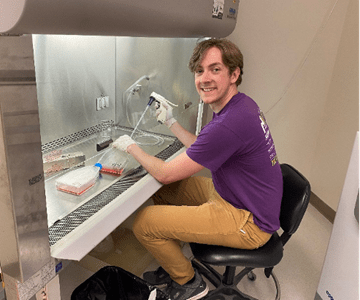The program – known as IMPRS – pairs students who just completed their first year of medical training with a faculty mentor. For eight to 12 weeks of their summer, the students conduct laboratory/translational or clinical research, network and attend seminars. Their work culminates in an end-of-the-summer oral and poster presentation.
IMPRS is IU School of Medicine’s official program for summer medical student research. This opportunity is specifically designed to attract those who are between their first and second years of medical school because it’s an ideal point in their education to take on such lengthy research projects.
Here are the students and orthopaedic faculty mentors working together this year, and a bit about each students’ project:
The Kacena Lab
Faculty mentor: Melissa Kacena, PhD
Christopher Dalloul: Bone health in a mouse-adapted model of SARS-CoV-2
Nicholas Hux: Effects of targeted TMP on fracture healing in aged mice
Abduallah Elsayed: The effects of targeted SRT1720 on bone fracture healing and pain behavior in mice
Samuel Zike: Effects of TMP and high fat diet on bone fracture healing
Nikhil Tewari: Effects of megakaryocyte products on bone marrow angiogenesis
The Gingery Lab
Faculty mentor: Anne Gingery, PhD
Nicholas Thelen: Studying the role of cellular senescence and immune evasion in musculoskeletal pathology, with the long-term goal of reducing senescent burden in aged and diseased tissues to improve healing.
The Meneghini Lab
Faculty mentor: Michael Meneghini, MD
Joshua Hsien-Shu Chang: The relative contribution of medical comorbidities in the OARA score to safe same-day and next-day discharge after total joint arthroplasty: A machine learning analysis
Ethan Cornwell: The influence of medial collateral ligament and lateral collateral ligament pie crusting in primary total joint arthroplasty on patient-reported outcomes
Colin Harris: Radiographic outliers, revisions, and functional outcomes in fixed-bearing medial unicompartmental arthroplasty
Luci Hulsman: Time required for planned and unplanned episodes of care in aseptic and septic hip and knee revision surgery
Amrit Parihar: Instability in patients with lumbar spine disease or lumbar fusion undergoing posterior approach vs. direct lateral approach primary total hip arthroplasty
The McKinley Lab
Faculty mentor: Todd McKinley, MD
Rebecca Nunge and Kayla Gates: Both are working on a project entitled Developing a Minimally Invasive Cell-Based Model to Predict Response to Major Trauma.
Taylor Luster: The objective of Taylor’s summer research is to measure trauma imposed by hemorrhagic shock and a femur fracture in a mouse model to determine if specific cytokines can serve as predictive values for response to trauma. This research will help determine how intrinsic differences between individuals can help predict survivability in polytrauma.
